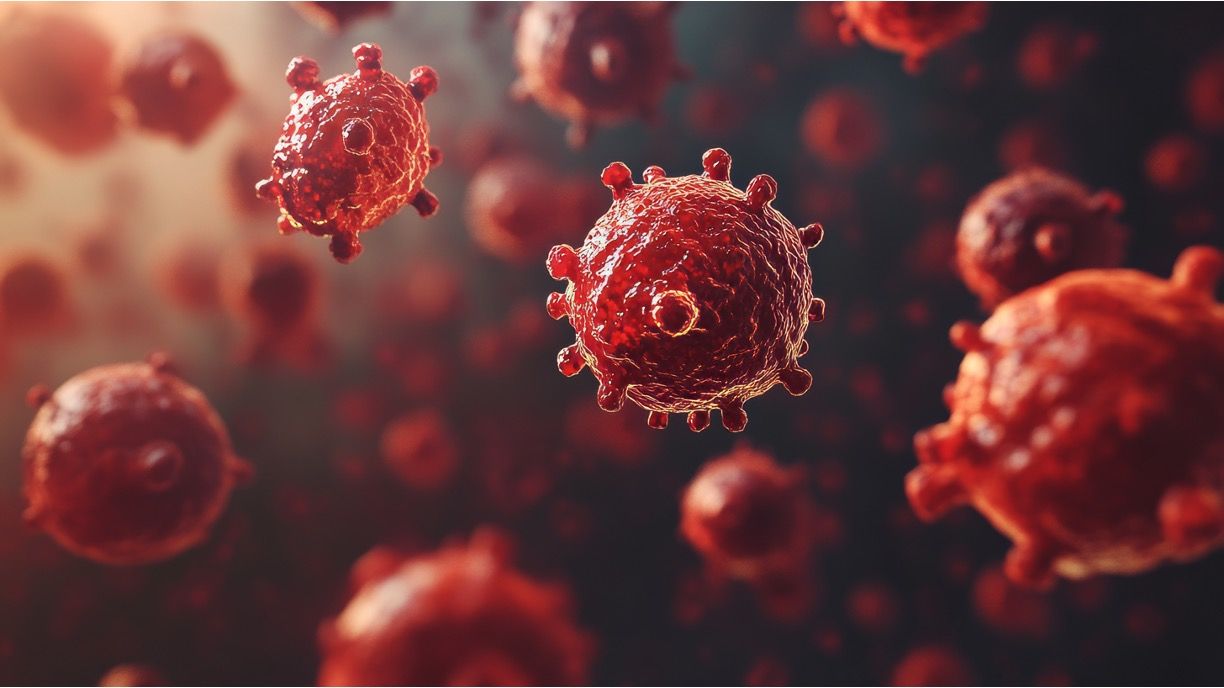New SERS-Microfluidic Platform Classifies Leukemia Using Machine Learning
A combination of surface-enhanced Raman spectroscopy (SERS) and machine learning on microfluidic chips has achieved an impressive 98.6% accuracy in classifying leukemia cell subtypes, offering a fast, highly sensitive tool for clinical diagnosis.
3D rendition of human leukemia cells in the bloodstream © Nicat - stock.adobe.com

Leukemia, a deadly hematological cancer causing nearly 24,000 deaths in 2024 in the United States (1), comprises multiple subtypes, each requiring distinct treatment regimens. Rapid and accurate classification is crucial for effective treatment. Traditional methods for diagnosing leukemia, such as flow cytometry and polymerase chain reaction (PCR) methods, often fall short in terms of sensitivity, speed, and accuracy. A novel approach combining surface-enhanced Raman spectroscopy (SERS) with machine learning (ML) algorithms and microfluidic technology has now shown the potential to rapidly advance leukemia diagnosis (2). The study, led by Kuo Yang, Jinjin Zhao, Ying Huang, Hai Sheng, and Zhuyuan Wang from Southeast University, Nanjing, was published in the journal Talanta, and demonstrates a SERS-based platform that accurately differentiates between two major leukemia types: acute lymphoblastic T-cell leukemia (T-ALL) and chronic myeloid leukemia (CML) (2).
The Technology Behind the Platform
The research team integrated ordered array-assisted SERS microfluidic chips with advanced ML algorithms for leukemia phenotyping. The platform leverages the unique properties of SERS, known for its fingerprint-like spectral signatures and high sensitivity (2,3). Unlike conventional flow cytometry or PCR, which require large sample volumes and sophisticated equipment, the SERS-microfluidic platform is more compact and efficient, capable of operating with minimal sample consumption. The microfluidic chips, enhanced with anodic aluminum oxide (AAO) templates, create a structured microenvironment that improves cell capture and analysis. These arrays ensure uniform fluid flow, boosting the platform's reproducibility and effectiveness (2).
Key Findings in Cell Capture and Analysis
One of the major innovations in this study is the design of the ordered array substrate. This substrate, made of silver-coated micro-pillars, optimizes the capture of leukemia cells. The team found that when compared to traditional flat substrates, the ordered structure significantly improved the uniformity and efficiency of cell capture. The increased surface roughness and the resultant turbulence in the microfluidic channel allow cells to be captured more effectively, with enhanced binding of the tumor cells to aptamers laid along the channel walls. Specifically, the system demonstrated 90% capture efficiency for T-ALL cells (CCRF-CEM) and 81% for CML cells (K562), which is a substantial improvement over previous systems that often struggled with low concentration samples. An aptamer is a short, single-stranded nucleic acid (DNA or RNA) that can bind to specific target molecules, such as leukemia cells, with high affinity and specificity (2).
SERS Probes for Phenotypic Analysis
To ensure the specificity and reliability of the platform, the researchers employed spectrally orthogonal SERS aptamer nanoprobes. These probes, which bind selectively to leukemia cells, produce stable, bright Raman signals upon excitation. The SERS spectra of the captured cells provide critical phenotypic information related to their surface protein expressions, which are crucial for differentiating leukemia subtypes. The incorporation of an ML model based on support vector machines (SVM) allowed for automatic analysis of these complex spectra, enabling precise subtype classification. The model achieved a 98.6% accuracy in distinguishing between T-ALL and CML in 73 real clinical blood samples, a testament to the power and accuracy of this approach (2).
ML Integration for Enhanced Diagnostic Speed
The integration of ML into the platform is another key feature that sets it apart from traditional diagnostic methods. The SVM algorithm processes the SERS data and classifies the leukemia subtypes with high accuracy. This automatic analysis not only reduces the time and effort required for diagnosis but also eliminates the human error factor inherent in traditional methods. The platform’s automation is expected to drastically reduce the time needed for leukemia typing from several days to less than one hour, offering a promising tool for real-time, precise clinical diagnostics (2).
Future Prospects and Challenges
While the results are highly promising, the study authors acknowledge two key limitations. The current SERS probe library does not yet cover all leukemia subtypes, and the microfluidic platform’s automation capabilities are still in development. However, with further refinement, including expanding the probe library and enhancing microfluidic automation, this technology could pave the way for a rapid, cost-effective, and highly accurate diagnostic platform for leukemia and potentially other multi-subtype diseases (2).
This research demonstrates the potential of combining SERS microfluidic chips with ML to advance clinical leukemia phenotyping. By enhancing both the sensitivity and specificity of leukemia cell detection, the platform could soon become an invaluable tool in precision medicine, providing fast and accurate diagnosis that could save many lives.
References
(1) US NIH Leukemia Page.https://seer.cancer.gov/statfacts/html/leuks.html (accessed 2024-01-24).
(2) Yang, K.; Zhao, J.; Huang, Y.; Sheng, H.; Wang, Z. Combining Array-Assisted SERS Microfluidic Chips and Machine Learning Algorithms for Clinical Leukemia Phenotyping. Talanta 2025, 283, 127148. DOI: 10.1016/j.talanta.2024.127148
(3) Ghazi, M. N.; Husain, B.; Heydaryan, K.; et al. A Review of Aptamer-Based Surface-Enhanced Raman Scattering (SERS) Platforms for Cancer Diagnosis Applications. BioNanoSci. 2025, 15, 44. DOI: 10.1007/s12668-024-01673-w
AI-Powered SERS Spectroscopy Breakthrough Boosts Safety of Medicinal Food Products
April 16th 2025A new deep learning-enhanced spectroscopic platform—SERSome—developed by researchers in China and Finland, identifies medicinal and edible homologs (MEHs) with 98% accuracy. This innovation could revolutionize safety and quality control in the growing MEH market.
New Raman Spectroscopy Method Enhances Real-Time Monitoring Across Fermentation Processes
April 15th 2025Researchers at Delft University of Technology have developed a novel method using single compound spectra to enhance the transferability and accuracy of Raman spectroscopy models for real-time fermentation monitoring.
Nanometer-Scale Studies Using Tip Enhanced Raman Spectroscopy
February 8th 2013Volker Deckert, the winner of the 2013 Charles Mann Award, is advancing the use of tip enhanced Raman spectroscopy (TERS) to push the lateral resolution of vibrational spectroscopy well below the Abbe limit, to achieve single-molecule sensitivity. Because the tip can be moved with sub-nanometer precision, structural information with unmatched spatial resolution can be achieved without the need of specific labels.